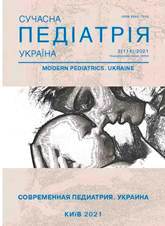Characteristic of exocrine function of the pancreas in premature newborns
DOI:
https://doi.org/10.15574/SP.2020.114.21Keywords:
premature, elastase, pancreatic insufficiencyAbstract
Premature babies in early postnatal ontogenesis are characterized by the immaturity of many functional systems, including the digestive system. The imperfection of the motor-evacuation function of the gastrointestinal tract in them is combined with insufficient activity of the enzyme systems, the peculiarities of the formation of the microbial landscape of the colon, which contributes to the development of digestive dysfunctions and complicates enteral feeding, especially in deeply premature infants.
In order to determine the parameters pancreatic elastase (PE) in premature infants, depending on the gestational age and the nature of feeding, 135 newborns were examined (108 premature infants with a gestational age of 22 to 32 weeks and 27 term infants). All children underwent a general clinical examination, as well as a study for PE on the 13–14th day of life, when the volume of enteral nutrition reached 70 percent or more. Analysis of the study results revealed a clear relationship between the degree of prematurity and the severity of pancreatic insufficiency. A clear relationship between fecal elastase indicators and the type of feeding was determined. The most favorable situation is observed in exclusively breastfed children, who have the highest fecal elastase values, which practically do not differ from the control values.
The research was carried out in accordance with the principles of the Helsinki Declaration. The study protocol was approved by the Local Ethics Committee of these Institutes. The informed consent of the patient was obtained for conducting the studies.
No conflict of interest was declared by the authors.
References
Alekseenko NYu. (2017). Osnovnyie problemyi i perspektivyi vyihazhivaniya detey s ochen nizkoy i ekstremalno nizkoy massoy tela pri rozhdenii. Simvol nauki. 2 (1): 158-163.
Belmer SV, Kostyrko EV, Privorotsky VF, Luppova NE. (2013). Aberrant pancreas in children. Issues of Pediatric Dietetics. 3 (11): 49-54. https://doi.org/10.20953/1727-5784-2013-3-49-54
Campeotto F, Kapel N, Kalach N. (2002). Low levels of pancreatic elastase 1 in stools of preterm infants. Arch Dis Child Fetal Neonatal Ed. 86: F198-F199. https://doi.org/10.1136/fn.86.3.F198; PMid:11978753 PMCid:PMC1721396
Ferrie S, Graham C, Hoyle M. (2011). Pancreatic enzyme supplementation forpatients receiving enteral feeds. Nutr Clin Pract. 26: 349-351. https://doi.org/10.1177/0884533611405537; PMid:21508176
Guillet R, Stoll BJ, Cotten CM et al. (2006). Association of H2-blockertherapy and higher incidence of necrotizing enterocolitis in very low birth weight infants. Pediatrics. 117: e137-142. https://doi.org/10.1542/peds.2005-1543; PMid:16390920
Jacques Rigo, Jean Michel Hascoet, Jean Charles Picaud, Fabio Mosca, Amandine Rubio, et al. (2020). Comparative study of preterm infants fed new and existing human milk fortifiers showed favourable markers of gastrointestinal status. Acta Paediatrica Wiley. 109 (3): 527-533. https://doi.org/10.1111/apa.14981; PMid:31435957 PMCid:PMC7028100
Keshishyan ES, Saharova ES, Alyamovskaya GA. (2017). Sovremennyie formyi organizatsii lechebno-profilakticheskoy pomoschi detyam, rodivshimsya nedonoshennyimi v Rossiyskoy Federatsii. ros vest Perinatol i pediatrii. 5: 6-15. https://doi.org/10.21508/1027-4065-2017-62-5-6-15
Lu'th S, Teyssen S, Forssmann K et al. (2001). Fecal elastase-1 determination:'gold standard' of indirect pancreatic function tests? Scand J Gastroenterol. 36: 1092-1099. https://doi.org/10.1080/003655201750422729; PMid:11589385
Munch A, Garten L, Buhrer C. (2013). Protracted Maturation of Pancreatic-Specific Elastase 1 Excretion in Preterm Infants of Extremely Low Gestational Age. Journal of Pediatric Gastroenterology and Nutrition. 56 (5): 532-536. https://doi.org/10.1097/MPG.0b013e31827fb091; PMid:23201702
Ryilova NV, Zholinskiy AV. (2020). Opredelenie urovnya pankreaticheskoy elastazyi kak «zolotoy standart» otsenki sostoyaniya podzheludochnoy zhelezyi v pediatricheskoy praktike. Eksperimentalnaya i klinicheskaya gastroenterologiya. 181 (9): 63-67. https://doi.org/10.31146/1682-8658-ecg-181-9-63-67
Ryilova NV. (2018). Pankreaticheskaya elastaza v diagnostike funktsionalnyih i strukturnyih izmeneniy podzheludochnoy zhelezyi u detey. Prakticheskaya meditsina. 2 (113): 66-69.
Rylova NV. (2010). Diagnosis of pancreatic diseases in children. Practical medicine. 3 (42): 120-124.
Spanier BW, Dijkgraaf MG, Bruno MJ. (2008). Epidemiology, aetiology and outcome of acute and chronic pancreatitis: An update. Best Pract Res Clin Gastroenterol. 22 (1): 45-63. https://doi.org/10.1016/j.bpg.2007.10.007; PMid:18206812
Terrin G, Passariello A, De Curtis M et al. (2012). Ranitidine is associated with infections, necrotizing enterocolitis, and fatal outcome in newborns. Pediatrics. 129: e40-45. https://doi.org/10.1542/peds.2011-0796; PMid:22157140
Downloads
Published
Issue
Section
License
Copyright (c) 2021 Modern Pediatrics. Ukraine

This work is licensed under a Creative Commons Attribution-NonCommercial 4.0 International License.
The policy of the Journal “MODERN PEDIATRICS. UKRAINE” is compatible with the vast majority of funders' of open access and self-archiving policies. The journal provides immediate open access route being convinced that everyone – not only scientists - can benefit from research results, and publishes articles exclusively under open access distribution, with a Creative Commons Attribution-Noncommercial 4.0 international license (СС BY-NC).
Authors transfer the copyright to the Journal “MODERN PEDIATRICS. UKRAINE” when the manuscript is accepted for publication. Authors declare that this manuscript has not been published nor is under simultaneous consideration for publication elsewhere. After publication, the articles become freely available on-line to the public.
Readers have the right to use, distribute, and reproduce articles in any medium, provided the articles and the journal are properly cited.
The use of published materials for commercial purposes is strongly prohibited.

